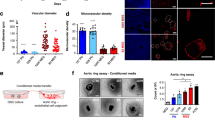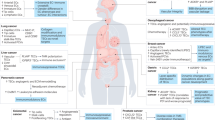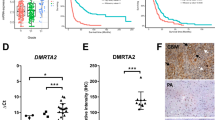Abstract
Glioblastoma (GBM) is among the most aggressive of human cancers1. A key feature of GBMs is the extensive network of abnormal vasculature characterized by glomeruloid structures and endothelial hyperplasia2. Yet the mechanisms of angiogenesis and the origin of tumour endothelial cells remain poorly defined3,4,5. Here we demonstrate that a subpopulation of endothelial cells within glioblastomas harbour the same somatic mutations identified within tumour cells, such as amplification of EGFR and chromosome 7. We additionally demonstrate that the stem-cell-like CD133+ fraction includes a subset of vascular endothelial-cadherin (CD144)-expressing cells that show characteristics of endothelial progenitors capable of maturation into endothelial cells. Extensive in vitro and in vivo lineage analyses, including single cell clonal studies, further show that a subpopulation of the CD133+ stem-like cell fraction is multipotent and capable of differentiation along tumour and endothelial lineages, possibly via an intermediate CD133+/CD144+ progenitor cell. The findings are supported by genetic studies of specific exons selected from The Cancer Genome Atlas6, quantitative FISH and comparative genomic hybridization data that demonstrate identical genomic profiles in the CD133+ tumour cells, their endothelial progenitor derivatives and mature endothelium. Exposure to the clinical anti-angiogenesis agent bevacizumab7 or to a γ-secretase inhibitor8 as well as knockdown shRNA studies demonstrate that blocking VEGF or silencing VEGFR2 inhibits the maturation of tumour endothelial progenitors into endothelium but not the differentiation of CD133+ cells into endothelial progenitors, whereas γ-secretase inhibition or NOTCH1 silencing blocks the transition into endothelial progenitors. These data may provide new perspectives on the mechanisms of failure of anti-angiogenesis inhibitors currently in use. The lineage plasticity and capacity to generate tumour vasculature of the putative cancer stem cells within glioblastoma are novel findings that provide new insight into the biology of gliomas and the definition of cancer stemness, as well as the mechanisms of tumour neo-angiogenesis.
This is a preview of subscription content, access via your institution
Access options
Subscribe to this journal
Receive 51 print issues and online access
$199.00 per year
only $3.90 per issue
Buy this article
- Purchase on Springer Link
- Instant access to full article PDF
Prices may be subject to local taxes which are calculated during checkout




Similar content being viewed by others
Change history
09 December 2010
A definition was completed in the first paragraph of the text.
References
Stupp, R. et al. Radiotherapy plus concomitant and adjuvant temozolomide for glioblastoma. N. Engl. J. Med. 352, 987–996 (2005)
Kleihues, P. et al. The WHO classification of tumors of the nervous system. J. Neuropathol. Exp. Neurol. 61, 215–225 (2002)
Kioi, M. et al. Inhibition of vasculogenesis, but not angiogenesis, prevents the recurrence of glioblastoma after irradiation in mice. J. Clin. Invest. 120, 694–705 (2010)
Lyden, D. et al. Impaired recruitment of bone-marrow-derived endothelial and hematopoietic precursor cells blocks tumor angiogenesis and growth. Nature Med. 7, 1194–1201 (2001)
Du, R. et al. HIF1alpha induces the recruitment of bone marrow-derived vascular modulatory cells to regulate tumor angiogenesis and invasion. Cancer Cell 13, 206–220 (2008)
The Cancer Genome Atlas Research Network. Comprehensive genomic characterization defines human glioblastoma genes and core pathways. Nature 455, 1061–1068 (2008)
Kreisl, T. N. et al. Phase II trial of single-agent bevacizumab followed by bevacizumab plus irinotecan at tumor progression in recurrent glioblastoma. J. Clin. Oncol. 27, 740–745 (2009)
Hovinga, K. E. et al. Inhibition of Notch Signaling in Glioblastoma Targets Cancer Stem Cells Via an Endothelial Cell Intermediate. Stem Cells 28, 1019–1029 (2010)
Dallas, N. A. et al. Endoglin (CD105): a marker of tumor vasculature and potential target for therapy. Clin. Cancer Res. 14, 1931–1937 (2008)
Voyta, J. C., Via, D. P., Butterfield, C. E. & Zetter, B. R. Identification and isolation of endothelial cells based on their increased uptake of acetylated-low density lipoprotein. J. Cell Biol. 99, 2034–2040 (1984)
Laib, A. M. et al. Spheroid-based human endothelial cell microvessel formation in vivo . Nature Protocols 4, 1202–1215 (2009)
Beaty, R. M. et al. PLXDC1 (TEM7) is identified in a genome-wide expression screen of glioblastoma endothelium. J. Neurooncol. 81, 241–248 (2007)
Verhaak, R. G. et al. Integrated genomic analysis identifies clinically relevant subtypes of glioblastoma characterized by abnormalities in PDGFRA, IDH1, EGFR, and NF1 . Cancer Cell 17, 98–110 (2010)
Singh, S. K. et al. Identification of human brain tumour initiating cells. Nature 432, 396–401 (2004)
Richardson, G. D. et al. CD133, a novel marker for human prostatic epithelial stem cells. J. Cell Sci. 117, 3539–3545 (2004)
Al-Hajj, M., Wicha, M. S., Benito-Hernandez, A., Morrison, S. J. & Clarke, M. F. Prospective identification of tumorigenic breast cancer cells. Proc. Natl Acad. Sci. USA 100, 3983–3988 (2003)
Shmelkov, S. V., St, C. R., Lyden, D. & Rafii, S. AC133/CD133/Prominin-1. Int. J. Biochem. Cell Biol. 37, 715–719 (2005)
Uchida, N. et al. Direct isolation of human central nervous system stem cells. Proc. Natl Acad. Sci. USA 97, 14720–14725 (2000)
Koh, W., Mahan, R. D. & Davis, G. E. Cdc42- and Rac1-mediated endothelial lumen formation requires Pak2, Pak4 and Par3, and PKC-dependent signaling. J. Cell Sci. 121, 989–1001 (2008)
Kamei, M. et al. Endothelial tubes assemble from intracellular vacuoles in vivo . Nature 442, 453–456 (2006)
Shen, Q. et al. Endothelial cells stimulate self-renewal and expand neurogenesis of neural stem cells. Science 304, 1338–1340 (2004)
Wurmser, A. E. et al. Cell fusion-independent differentiation of neural stem cells to the endothelial lineage. Nature 430, 350–356 (2004)
Hendrix, M. J. et al. Transendothelial function of human metastatic melanoma cells: role of the microenvironment in cell-fate determination. Cancer Res. 62, 665–668 (2002)
El Hallani, S. et al. A new alternative mechanism in glioblastoma vascularization: tubular vasculogenic mimicry. Brain 133, 973–982 (2010)
Akino, T. et al. Cytogenetic abnormalities of tumor-associated endothelial cells in human malignant tumors. Am. J. Pathol. 175, 2657–2667 (2009)
Iwamoto, F. M. et al. Patterns of relapse and prognosis after bevacizumab failure in recurrent glioblastoma. Neurology 73, 1200–1206 (2009)
Panchision, D. M. et al. Optimized flow cytometric analysis of central nervous system tissue reveals novel functional relationships among cells expressing CD133, CD15, and CD24. Stem Cells 25, 1560–1570 (2007)
Franco-Hernandez, C. et al. Gene dosage and mutational analyses of EGFR in oligodendrogliomas. Int. J. Oncol. 30, 209–215 (2007)
Mellinghoff, I. K. et al. Molecular Determinants of the response of glioblastomas to EGFR kinase inhibitors. N. Engl. J. Med. 353, 2012–2024 (2005)
Brennan, C. et al. Glioblastoma subclasses can be defined by activity among signal transduction pathways and associated genomic alterations. PLoS ONE 4, e7752 (2009)
Guo, P. et al. Dual nature of the adaptive immune system in lampreys. Nature 459, 796–801 (2009)
Acknowledgements
We would like to thank J. Imai, H. Xu, G. Lee, M. Tomishima and L. Studer for critical reading of the manuscript, P. Gutin for assistance with tissue acquisition and discussions, B. Weksler for the brain endothelial cell line (hCMEC), S. Jhanwar for the clinical cytogenetics data and M. Sadelain and E. Papapetrou for the lentiviral vectors. Funding was provided in part through a grant from the New York State Stem Cell Science Fund (NYSTEM).
Author information
Authors and Affiliations
Contributions
R.W. and V.T. conceived the project, analysed the data and wrote the manuscript. R.W. and remaining authors performed experiments and analysed data.
Corresponding author
Ethics declarations
Competing interests
The authors declare no competing financial interests.
Supplementary information
Supplementary Information
The file contains Supplementary Figures 1-9 with legends and Supplementary Tables 1-6. (PDF 6124 kb)
Rights and permissions
About this article
Cite this article
Wang, R., Chadalavada, K., Wilshire, J. et al. Glioblastoma stem-like cells give rise to tumour endothelium. Nature 468, 829–833 (2010). https://doi.org/10.1038/nature09624
Received:
Accepted:
Published:
Issue Date:
DOI: https://doi.org/10.1038/nature09624
This article is cited by
-
Profiling human brain vascular cells using single-cell transcriptomics and organoids
Nature Protocols (2024)
-
Bevacizumab and gamma knife radiosurgery for first-recurrence glioblastoma
Journal of Neuro-Oncology (2024)
-
Comprehensive Review on the Effect of Stem Cells in Cancer Progression
Current Tissue Microenvironment Reports (2024)
-
Lymphatic endothelial-like cells promote glioblastoma stem cell growth through cytokine-driven cholesterol metabolism
Nature Cancer (2024)
-
Cross-talk between cancer stem cells and immune cells: potential therapeutic targets in the tumor immune microenvironment
Molecular Cancer (2023)
Comments
By submitting a comment you agree to abide by our Terms and Community Guidelines. If you find something abusive or that does not comply with our terms or guidelines please flag it as inappropriate.



